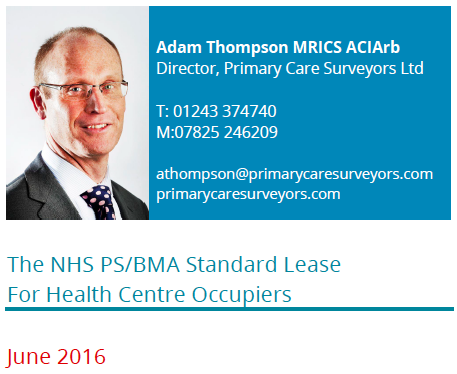
Further to my previous article, many of you will have seen features in the media about the “standard GP lease” that has been agreed between NHS Property Services and the BMA.
This is an encouraging step forward and has been much anticipated. I am always concerned about how standardised such agreements can be, when there is much that needs to be negotiated depending on the particular dynamics of the Practice, as well as to reflect the physical circumstances of the premises.
I have reviewed the proposed lease and would comment as follows:
Term: This is not prescribed in the standard lease, so clearly there can be a wide variance. I have been advised verbally that terms may be sought of 15 years but with break clauses.
Break Clauses: As previously, NHS Property Services are insisting upon there being a break clause in the event that the tenant loses their NHS contract. This is probably of mutual benefit.
Where the lease is quite generous is in the principal of “last man standing”, which allows the tenant to serve notice to break the lease in the event that the core contract has been terminated or is not to be renewed. This is more favourable than would generally be agreeable to private sector landlords.
Assignment (Transfer of Lease): The wording is broadly similar to that agreeable to private sector landlords, in that the lease can be assigned to other GP practices without the landlord’s consent. However, to assign the lease to an NHS body does require the landlord’s consent, whereas landlords’ consent is rarely required with private sector landlords.
Repairs: As most of the buildings are in shared use, it is only practicable for the tenant to be directly responsible for repairs to the interior of their accommodation, however this needs to be viewed in connection with any service charge.
Service Charge: This has been a thorny issue in the past and it rather appears that this will continue to be so. The proposal is that NHS Property Services is seeking to move to a position of full recovery of service charges. The wording of the draft lease states that the landlord is to be responsible for the exterior and structure of the building, but these costs then form part of the service charge. This means that each individual tenant will pay towards the costs of external repairs and maintenance which, for some buildings, may potentially be quite onerous given their age and lack of repair over numerous years. Whilst there may be a ‘Schedule of Condition’ to limit a tenant’s potential liability, to make a lease a straightforward internal repairing only lease will avoid potential future dispute.
Shared Areas: With the buildings being of shared use, there have been issues as to areas that are subject to rent and areas that fall within service charge. This complication looks set to continue with the leases containing a provision for “shared area rents”, which is generally a proposal that private sector landlords would not wish to consider.
Rent: Again, in the media, you may have seen articles about rents going to now be “market rent”. This is a positive step forward since it will bring the rents in line with the definition of Current Market Rent as used for premises that are owner occupied. Providing the “market rent” is reimbursed to the Practice, this should be at nil additional cost to the Practice, but should lead to a positive revenue advantage to NHS Property Services, which then may detract some of the focus from trying to maximise service charges.
Whilst the draft lease says the memorandum to document the rent at review can be submitted to NHS England without being signed, the NHS Premises Directions 2013 state that the memorandum must be signed. With the Premises Directions due to be reviewed, this contradiction may then be resolved.
Rent Reviews: Rents are to be 3 yearly and the lease does contain a safeguard provision that the lease rents will not exceed the amount of rent you are reimbursed by the NHS.
Costs: When a lease is created, there is a liability by the tenant to pay Stamp Duty Land Tax (SDLT). Linked to this draft lease there is the General Practice Forward View, as published in April 2016. This confirms that NHS England will reimburse practices SDLT for leases that come into place on 1 May 2016 until 31 October 2016, so there will clearly be financial pressure put onto Practices to enter into leases swiftly. I am concerned that this pressure may be brought to bear with Practices then agreeing to onerous provisions (notably service charge arrangements) that may prove to be significantly costly over the term of the lease.
Facilities Management: In my discussions with NHS Property Services, they have often referred to the provision of facilities management and how this is a key component of their service charge. I have even had someone from NHS Property Services confirm that the organisation is a FM company rather than a property company! The pressure for them to maximise FM revenue is presumably having a major bearing on the pressure that will be on service charge arrangements.
As mentioned, the NHS Premises Directions are undergoing review. It is anticipated that the new Directions will be published in September or October this year.

